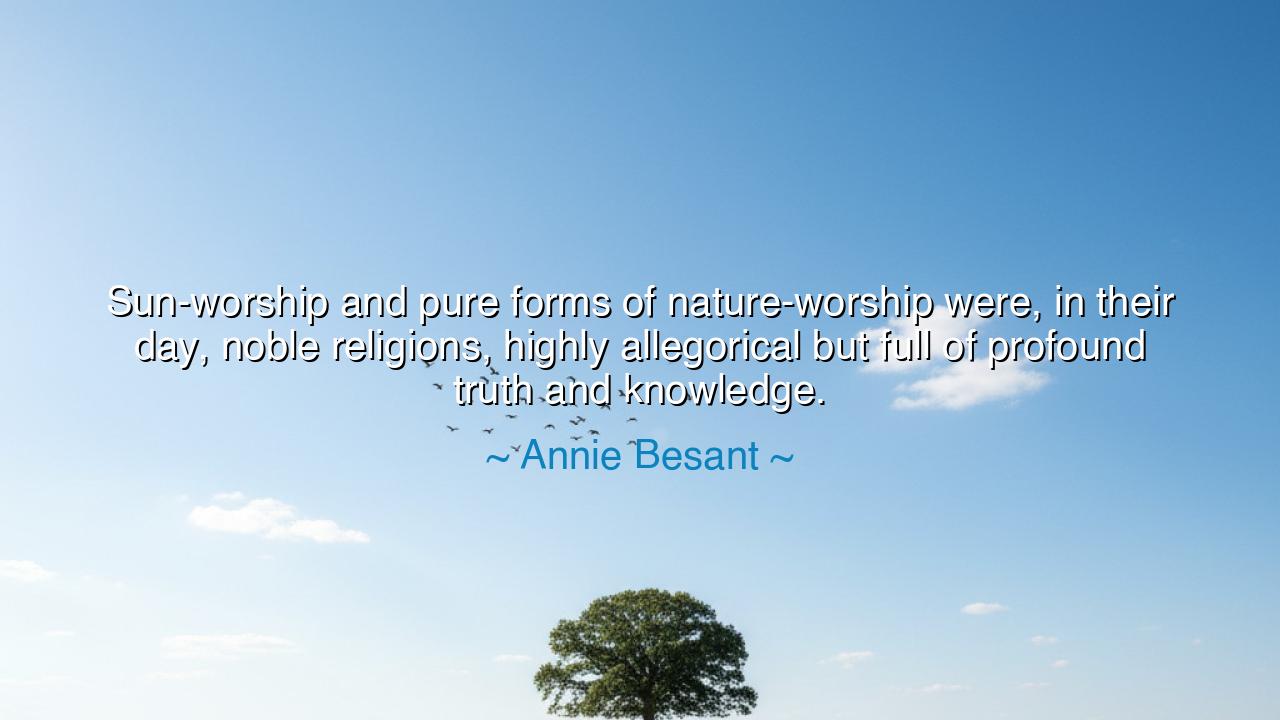
Sun-worship and pure forms of nature-worship were, in their day
Sun-worship and pure forms of nature-worship were, in their day, noble religions, highly allegorical but full of profound truth and knowledge.






Annie Besant, the mystic and reformer who sought to unite the wisdom of East and West, once declared: “Sun-worship and pure forms of nature-worship were, in their day, noble religions, highly allegorical but full of profound truth and knowledge.” In these words, she did not merely defend ancient faiths long dismissed as primitive, but revealed the hidden dignity within them. For what are sun-worship and nature-worship but humanity’s earliest attempts to grasp the eternal, to bow before the powers that sustain life, and to shape that reverence into symbols of truth? To the ancients, the rising of the sun was not merely light in the sky—it was hope, renewal, victory over darkness. In revering it, they were not foolish, but wise in allegory, seeing the eternal through the visible.
The ancients themselves bore this reverence in their very bones. The Egyptians raised mighty temples to Ra, the sun-god, recognizing in his daily journey across the heavens the rhythm of life and death, of struggle and rebirth. To them, sun-worship was not only ritual, but philosophy—a reminder that light conquers shadow, that warmth sustains the harvest, and that without the sun’s fire, man is nothing. Likewise, in India, the Vedic hymns to Surya, the sun, speak not only of a blazing orb but of the knowledge and truth the light reveals. In their worship of nature, men were teaching themselves to see deeper than form, to honor the source that nourishes all life.
Besant called these religions “highly allegorical,” for indeed they were not blind idolatries but symbolic languages. When men bowed to the sun, they bowed to the principle of illumination, wisdom, and life-giving force. When they revered rivers, mountains, or trees, they were honoring fertility, strength, endurance, and renewal. The stories and myths woven around these symbols became maps of inner truth, guiding humanity’s earliest steps toward philosophy and spirituality. Thus, what seems simple to modern eyes was in truth a profound schooling of the soul.
Consider the story of the Inca Empire, where the sun was worshipped as Inti, father of the people. To them, the sun’s radiance was not only physical power but a spiritual inheritance. The Sapa Inca, child of the sun, was charged not with tyranny but with ensuring harmony, justice, and prosperity. Their worship taught them responsibility, unity, and reverence for the natural world. Though their empire eventually fell, the wisdom of their sun-worship still speaks: to govern is to reflect the light, to bring warmth to the people, to be a steward of life.
What Besant wished to remind us is that in mocking these faiths as “primitive,” modernity blinds itself to their knowledge. For the ancient worshippers of the sun understood something we too often forget—that man is bound to nature, that life depends upon harmony with the forces of earth, fire, water, and air. To honor nature is to recognize one’s place in the cosmos. To despise it is to cut oneself from the roots of life itself. Their reverence was not ignorance but humility, a posture that saw the sacred woven through the world.
The lesson for us is urgent. In an age of machines and cities, of steel and fire, we risk losing the reverence our ancestors knew. Yet the sun still rises. The rivers still flow. The earth still feeds us. To return to nature-worship in its noblest sense does not mean bowing before idols, but awakening again to the sacredness of the world we inhabit. It means recognizing that to harm nature is to blind ourselves, to destroy the very light that sustains us. Besant’s words call us to recover the wisdom in ancient allegories and let them guide us once more toward balance, humility, and reverence.
Practical action follows. Watch the sunrise with reverence, and let it remind you that each day is renewal. Walk among the trees and honor them not only as wood and shade, but as living symbols of endurance. Drink water and remember it as the source of life. Teach your children not only science but reverence, so they may see both the fact and the mystery in nature. In this way, you will live as the ancients did: not blind in superstition, but alive in wonder.
Thus, children of the future, remember Besant’s teaching: sun-worship and nature-worship were noble religions, full of profound truth. Do not despise the ancient ways, for within them lies wisdom that can heal our blindness. Learn again to read the allegories of nature, to see the eternal in the visible, and to honor the sources of life with humility. For in revering nature, you do not bow to stone or fire—you bow to the mystery of existence itself, and in that bow, you rise into wisdom.






AAdministratorAdministrator
Welcome, honored guests. Please leave a comment, we will respond soon